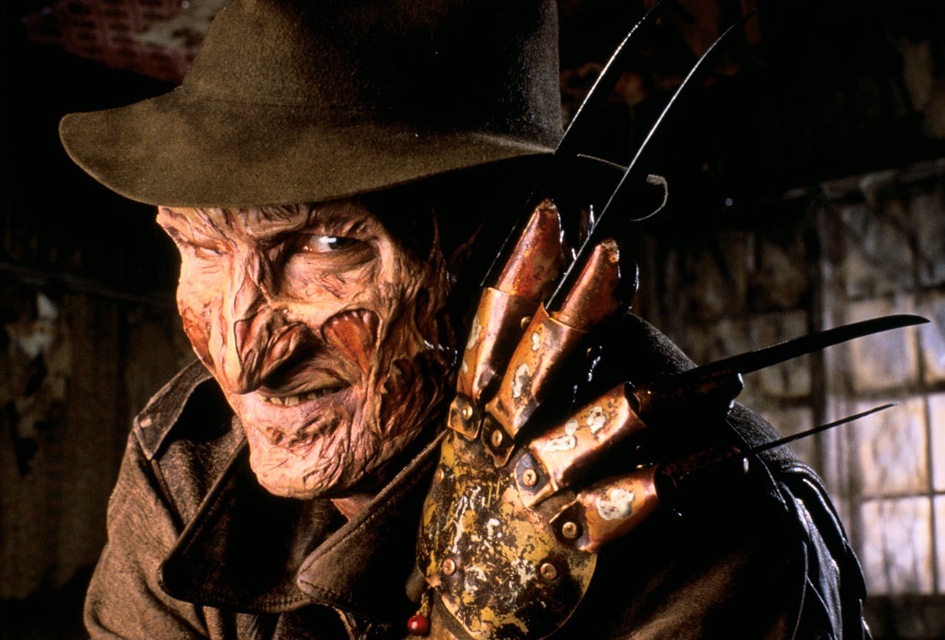
A Nightmare on Elm Street is a 1984 horror film written and directed by Wes Craven. The story revolves around a small group of teens who are terrorized in their dreams by a demonic specter, a man with knives on his fingers named Fred Krueger. When the teens fall asleep, they are murdered in mysterious and gruesome ways. It’s up to Nancy, played by Heather Langenkamp, to stay awake and stop Freddy before it’s too late.
Warning: This review will contain spoilers for A Nightmare on Elm Street.
Crafting a Killer
A Nightmare on Elm Street is most famous for its wise-cracking villain, Freddy Krueger. When crafting villains for their slasher movies, many filmmakers focus on creating a recognizable silhouette and letting the murders speak for themselves. This approach lends itself well to an atmosphere of dread, but it can make for a boring antagonist. Freddy only speaks a few times in his first film, but next to his silent slasher contemporaries, like Michael Myers and Jason Vorhees, he’s downright chatty.
Despite the fact that Freddy Krueger is one of the most supernatural slasher villains, his interactions with his victims gives him a sense of tangibility that other villains lack. For instance, the scares in Halloween depend on the audience’s discomfort when they can’t find Michael Myers on screen. Meanwhile, A Nightmare on Elm Street makes no effort to hide Freddy’s location or his intentions. He takes up the whole frame, cruelly stalking his prey in plain view.
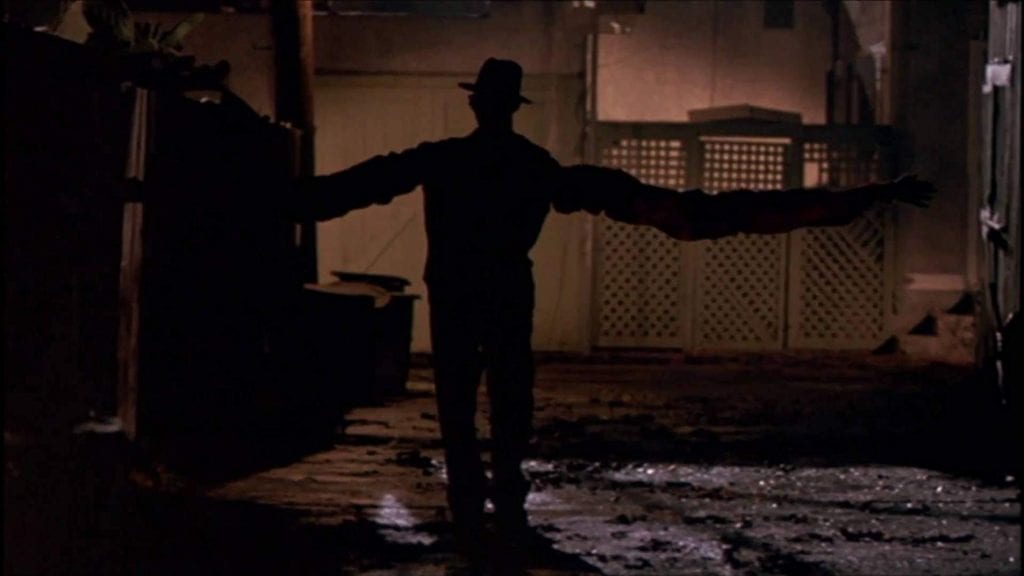
This makes Freddy Krueger unique in the classic slasher genre. Michael Myers and Jason Vorhees are swathed in mysterious layers of lore and hidden motivations; their bodies nondescript, their faces covered with masks. Fred Krueger doesn’t need a mask. His greatest strength as a movie monster is his personality. He’s not just terrifying because he kills teenagers, but because he delights in torturing them. This is not because he’s avenging wrongs or making a moral judgement. Fred Krueger likes to kill kids.
The Monster Movie Paradox
With his iconic design and Robert Englund’s chillingly gleeful performance, Freddy Krueger was destined to terrify audiences for years with numerous sequels, reboots, and re-imaginings. But throughout his killing career, Krueger’s greatest strength has also become his greatest weakness. His personality grew with each film, at the expense of the protagonists. Audiences no longer cared about the plight of his victims, and Freddy Krueger became the focal point of his own franchise.

This is a well-documented phenomenon in horror movie franchises. Audiences will often identify with the most well-rounded character on-screen. In a horror franchise, the most well-rounded character is usually the villain. This is even more true for a monster like Freddy, who is dripping with personality. Throughout the franchise, the point of view has shifted to favor Freddy, a move meant to capitalize on his popularity. This change, however, comes at the expense of the franchise as a whole. Because a monster movie should never be about the monster.
The horror genre is at its best when it utilizes archetypes and metaphor. The goal is to disturb audiences by playing on universal, primal fears in creative and thought-provoking ways. For instance, The Babadook’s top-hatted monster may technically be the villain of the film, but the true antagonist is Amelia’s grief and resentment. The purpose of the monster is to give the characters an external surrogate for their internal struggles. But if the monster fails to capture an audience’s imagination, then the metaphor loses its poignancy.
This is where A Nightmare on Elm Street truly shines, especially when compared to its successors. Freddy Krueger is just as charismatic as he is terrifying, but the movie isn’t really about him. A Nightmare on Elm Street is about a teenager’s fractured relationship with her parents.
Parents Just Don’t Understand
The late 1970’s saw a huge uptick in child murders and disappearances. During this time, PSAs were created; like the infamous “Stranger Danger” commercial, warning children about abduction. Unfortunately, these PSAs weren’t very effective. Serial killings and mass murders continued to rise throughout the 1970’s and 1980’s. John Wayne Gacy and Ted Bundy became household names. For children and teens, the threat of abduction and murder was the new normal. Horror films of this era reflected the growing national panic surrounding child safety.

Stories like IT and A Nightmare on Elm Street take this idea a step further, focusing on the older generation’s failure to act. The parents in A Nightmare on Elm Street prefer to pretend that the danger has passed, even though children are still dying. And they are so obsessed with maintaining this illusion that they put their children directly in harm’s way.
Nancy Thompson is a kind, intelligent, well-adjusted young woman. Throughout the film, she seeks help from authority figures. Her parents, the police, and doctors all dismiss Nancy’s concerns. It’s possible that the deaths of Rod and Glenn could have been prevented if anyone had listened to her. Instead, Nancy is treated with condescension and disdain.
When Nancy asks her doctor for a prescription to stop her from dreaming, he responds that people need to dream, or they’ll go insane. But in the very next scene, he admits to Nancy’s mother that scientists still don’t completely understand why people dream. This means that he refused Nancy’s request out of hand. This casual dismissiveness comes up a lot in teen movies, especially from the 1980’s. The Breakfast Club may not feature a child murderer, but it does delve into the pain of being powerless.
Gaslighting a Generation
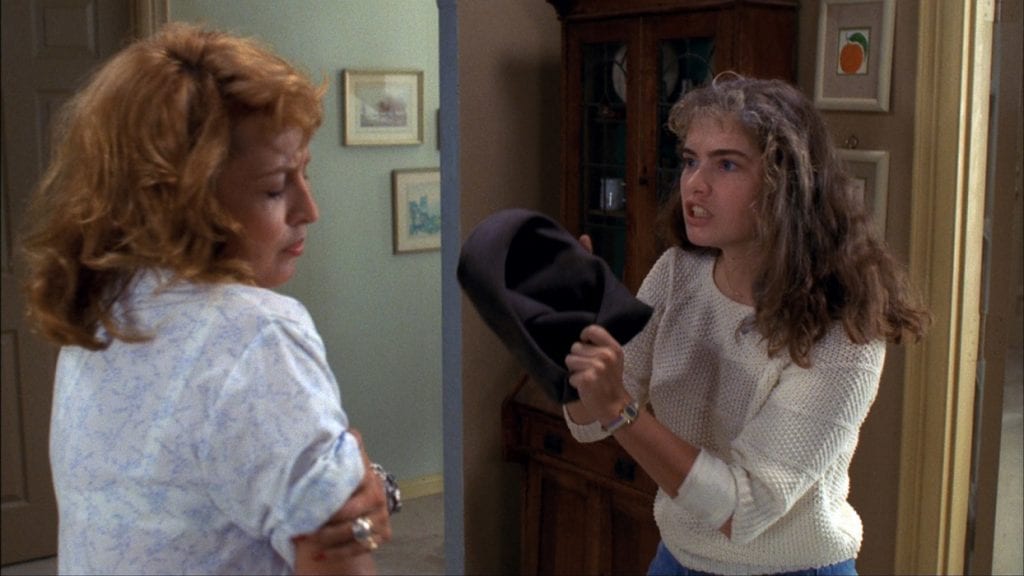
“Fred Krueger, Mom! Fred Krueger! Do you know who that is, Mother? Because if you do, you’d better tell me ‘cause he’s after me now!”
A Nightmare on Elm Street
The term “gaslighting” comes from the 1944 thriller Gaslight, in which a husband convinces his wife that she is insane so that he can take advantage of her. Since the film’s release, the term has come into wider use to describe an abusive tactic, where the abuser manipulates their victim into questioning reality. This creates an unhealthy power dynamic between the abuser and victim and can cause lasting emotional damage.
In A Nightmare on Elm Street, Nancy’s parents gaslight their own child. Early on in the film, Nancy’s parents dismiss her concerns as hysterical. But when Nancy finally describes Fred Krueger’s finger knives, Nancy’s mother jumps into action. She has her daughter committed to a hospital, where they force her to go to sleep.
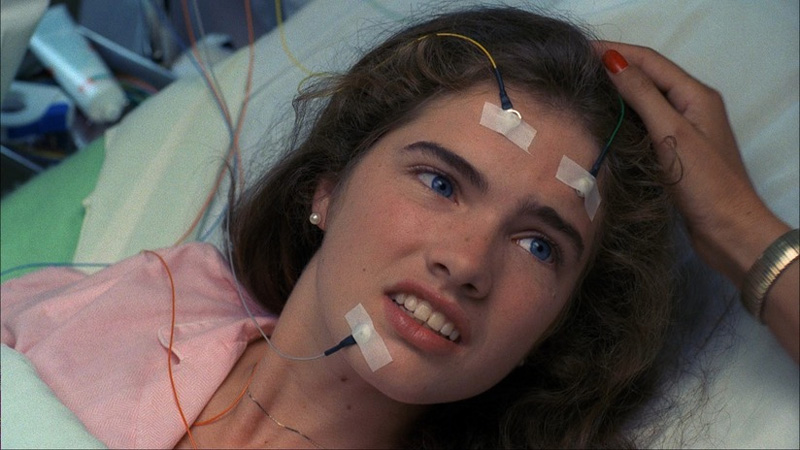
Nancy’s mother knows who Fred Krueger is. She knows that Nancy’s description of her attacker can’t be coincidence. Despite this, she chooses to let Nancy believe that she is simply suffering from sleep deprivation and delusion. Meanwhile, Nancy’s father continues to ignore her every time she mentions Freddy Krueger. Instead of listening to her, they put bars on Nancy’s windows, claiming it’s for her own safety.
These people not only know who Fred Krueger is, but also know about his violent nature and the circumstances surrounding his death. But instead of revealing this information to their clearly distressed daughter, they prioritize their own need for comfort. They prefer to drive their daughter insane, rather than face the terrible truth.
Sins of the Father
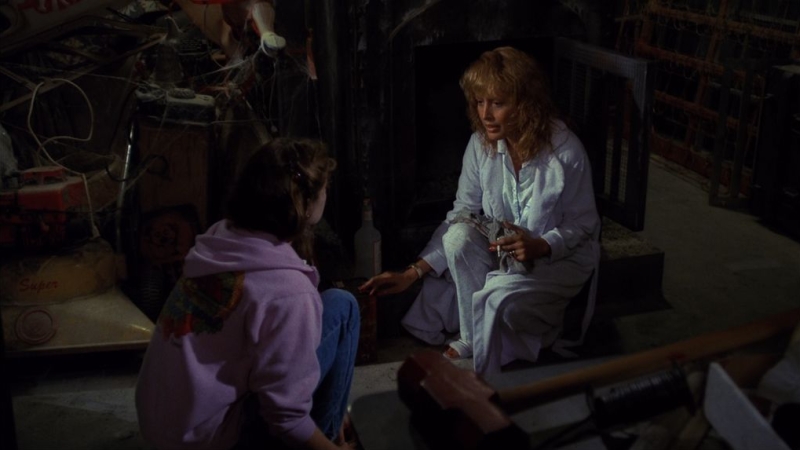
“We took gasoline and poured it all around the place and made a trail of it out the door. We lit the whole thing up and watched it burn. He’s dead now. He’s dead because Mommy killed him.”
A Nightmare on Elm Street
Freddy Krueger, the monster, isn’t just a child murderer. He is also a manifestation of guilt. The parents of Elm Street took the law into their own hands and murdered a man. Whether or not the murder was justified, they’re still haunted by the memory of their actions. Though it’s not explicitly stated in the film, it’s also insinuated that Nancy and her friends may have had siblings, who fell victim to the child murderer. It’s understandable that the parents of Elm Street wouldn’t want to revisit those terrible memories.
However, ignoring a problem doesn’t make it go away. The memory of Fred Krueger looms over the entire town, eating away at its citizens like a sickness. And as is so often the case, the younger generation must pay for their parents’ crimes. The teenagers in A Nightmare on Elm Street don’t have the luxury of ignoring their problems.
“Maybe I should just pick up that bottle and veg out with you, ignore everything going on around me by getting good and loaded.”
A Nightmare on Elm Street
Nancy takes care of her alcoholic mother, even after her betrayal. This role-reversal shows the audience the extent to which these parents have failed their kids. Nancy is terrified, sleep-deprived, mourning her friends, and worried that she might be insane, but she takes time to comfort her mother, nonetheless.
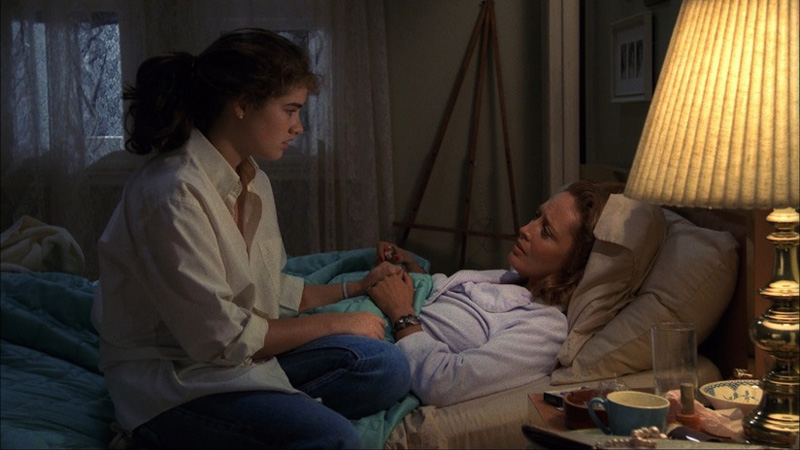
Nancy’s parents think that ignoring Freddy will rob him of his power. Technically, this is true. The difference is that Nancy faces him first. Freddy feeds on fear and lies. Nancy defeats him with honesty and courage.
Final Thoughts
On the surface, A Nightmare on Elm Street is a typical slasher film; full of tired tropes and cheesy effects. But scratch the surface, and viewers will find a subtly layered story about generational struggle. The film is suspenseful, dramatic, and incredibly gory. And of course, it features the one and only king of nightmares, Freddy Krueger.
I highly recommend that older viewers revisit the classic with a new perspective, and that younger viewers search for themselves in Nancy and her friends. The original A Nightmare on Elm Street is sure to hit home for a new generation of disenfranchised teenagers. The most important lesson of this horror classic is to listen to our children, and that message will always remain poignant, no matter what year it is.



